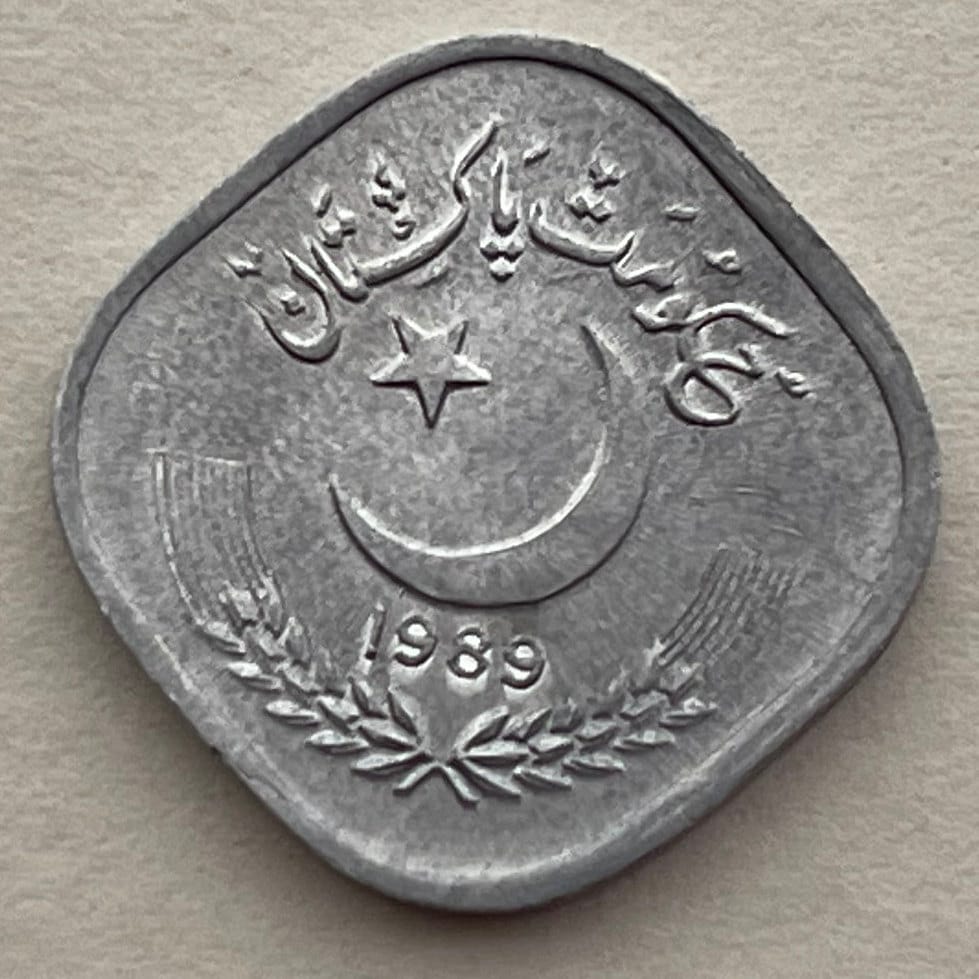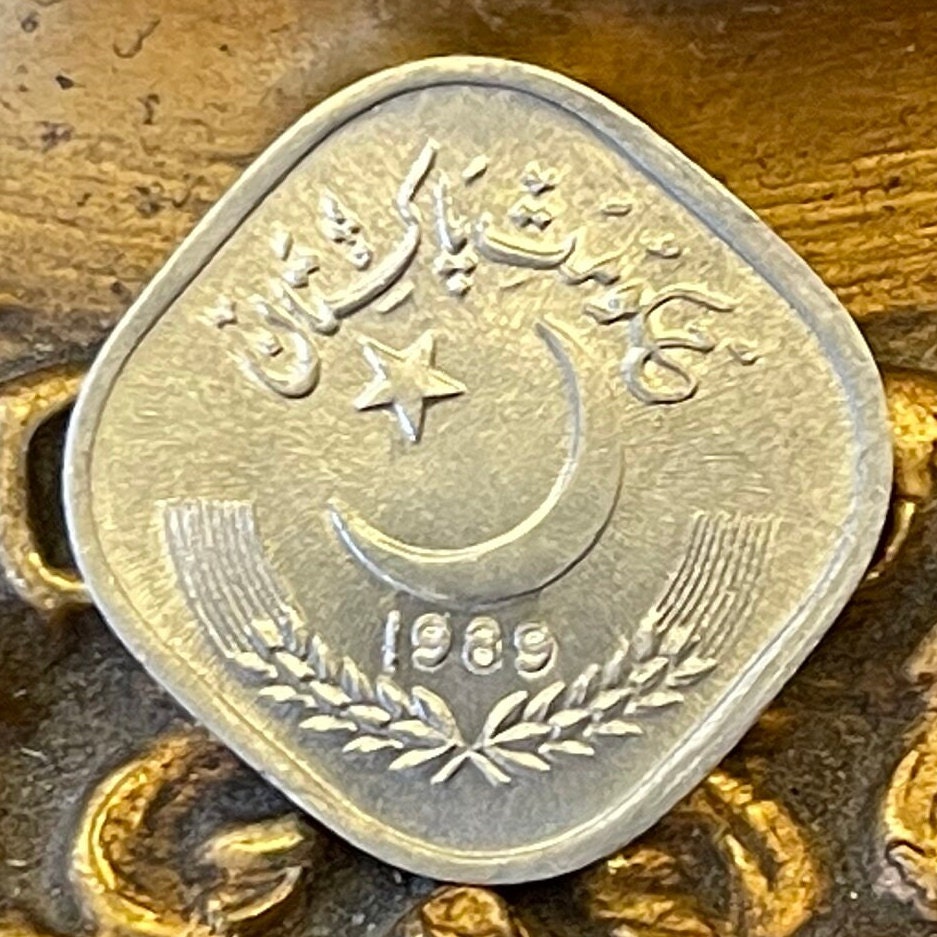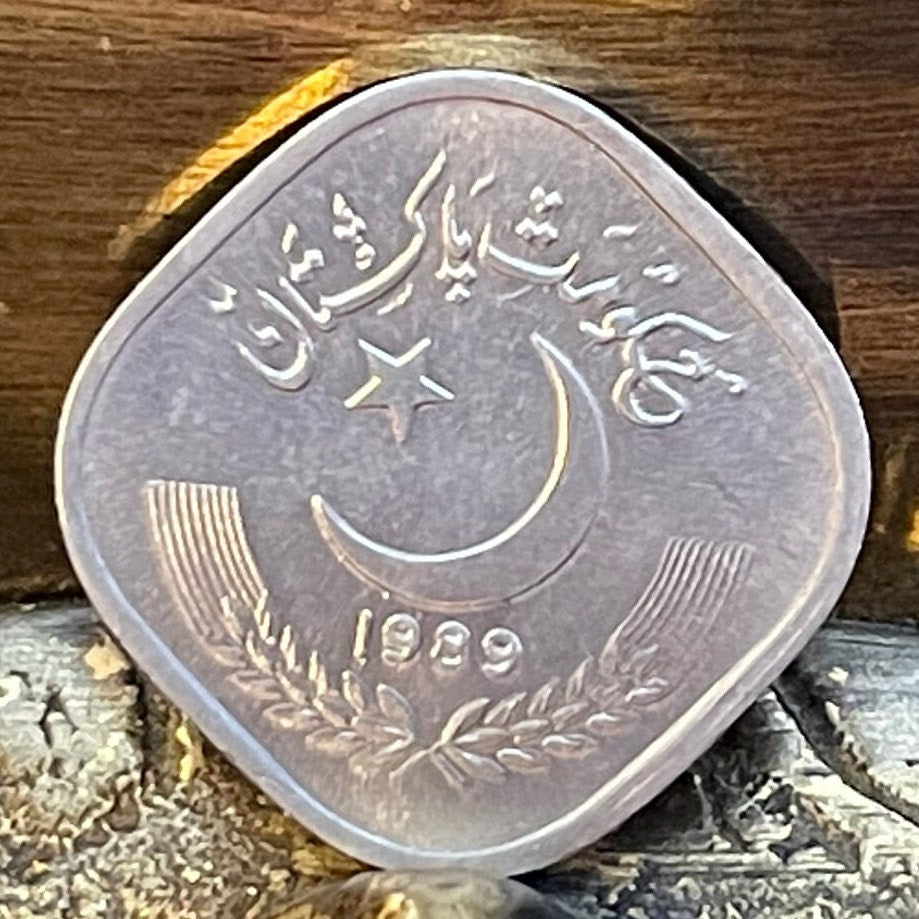elemintalshop
Star and Crescent 5 Paisa Pakistan Authentic Coin Money for Jewelry and Craft Making (Sugar Cane)
Star and Crescent 5 Paisa Pakistan Authentic Coin Money for Jewelry and Craft Making (Sugar Cane)
Couldn't load pickup availability
Star & Crescent 5 Paisa Islamic Republic of Pakistan Authentic Coin Charm for Jewelry and Craft Making (Sugar Cane)
Obverse: Crescent, star and date above ears
Lettering:
حكومت پاکستان
Translation: Government of Pakistan
Reverse: Value within sugar cane flanked by stars
Lettering: 5 پيسه
Translation: 5 Paisa
Features
Issuer Pakistan
Period Islamic Republic (1956-date)
Type Standard circulation coin
Years 1981-1996
Value 5 Paisa (0.05 PKR)
Currency Rupee (decimalized, 1961-date)
Composition Aluminium
Weight 1 g
Diameter 21 mm
Thickness 1.7 mm
Shape Square with rounded corners
Technique Milled
Orientation Medal alignment ↑↑
Demonetized 30 September 2014
Number N# 1276
References KM# 52, Schön# 57
Wikipedia:
he National Flag of Pakistan (Urdu: اسلامی جمہوریہ پاکستان کا پرچم) was adopted in its present form during a meeting of the Constituent Assembly of Pakistan on 11 August 1947, three days before the country's independence, when it was adopted by the All-India Muslim League as the official flag-to-be of the Dominion of Pakistan. The flag was retained upon the establishment of a constitution in 1956, and remains in use as the national flag for the present-day Islamic Republic of Pakistan. The flag is made up of a green field with a tilted white crescent moon and five-pointed star at its centre, and a vertical white stripe at its hoist-end. Though the specific shade of green is mandated only as 'dark green', its official and most consistent representation is Pakistan green, which is shaded distinctively darker.
The flag is notably referred to in the third verse of Pakistan's national anthem as the 'Flag of the Star and Crescent' (Persian: پرچمِ ستارہ و ہلال, رہبرِ ترقّی و کمال, romanized: Parcam-i sitārah o-hilāl, Rahbar-i taraqqī o-kamāl; transl. 'The flag of the crescent and star, Leads the way to progress and perfection,')
The crescent represents progress and the five-pointed star represents light and knowledge. The flag symbolises Pakistan's commitment to Islam and the rights of religious minorities.
*************
Wikipedia:
In the later 20th century, the star and crescent have acquired a popular interpretation as a "symbol of Islam", occasionally embraced by Arab nationalism or Islamism in the 1970s to 1980s, but often rejected as erroneous or unfounded by Muslim commentators in more recent times.
*******
Wikipedia:
The star and crescent is an iconographic symbol used in various historical contexts, prominently as a symbol of the Ottoman Empire, with numerous modern countries still using it as a national symbol. It is also often it was developed at Kingdom of Pontus at Hellenistic period considered as a symbol of Islam by extension. It is the conjoined representation of a crescent and a star, both elements have a long prior history in the iconography of the Ancient Near East as representing either the Sun and Moon or the Moon and Morning Star (or their divine personifications). Coins with crescent and star symbols represented separately have a longer history, with possible ties to older Mesopotamian iconography. The star, or Sun, is often shown within the arc of the crescent (also called star in crescent, or star within crescent, for disambiguation of depictions of a star and a crescent side by side); In numismatics in particular, the term crescent and pellet is used in cases where the star is simplified to a single dot.
The combination is found comparatively rarely in late medieval and early modern heraldry. It rose to prominence with its adoption as the flag and national symbol of the Ottoman Empire and some of its administrative divisions (eyalets and vilayets) and later in the 19th-century Westernizing tanzimat (reforms). The Ottoman flag of 1844, with a white ay-yıldız (Turkish for "crescent-star") on a red background, continues to be in use as the flag of the Republic of Turkey, with minor modifications. Other states formerly part of the Ottoman Empire also used the symbol, including Libya (1951–1969 and after 2011), Tunisia (1831) and Algeria (1958). The same symbol was used in other national flags introduced during the 20th century, including the flags of Azerbaijan (1918), Pakistan (1947), Malaysia (1948), Singapore (1959), Mauritania (1959), Uzbekistan (1991), Turkmenistan (1991), Comoros (2001).
Share










I asked for specific years, and the shop owner accommodated my preference. The coins arrived nicely packaged in clear plastic sleeves.
5 stars review from Shannon
5 stars review from Megan
Very nice coin from the old country.
5 stars review from Crystal









